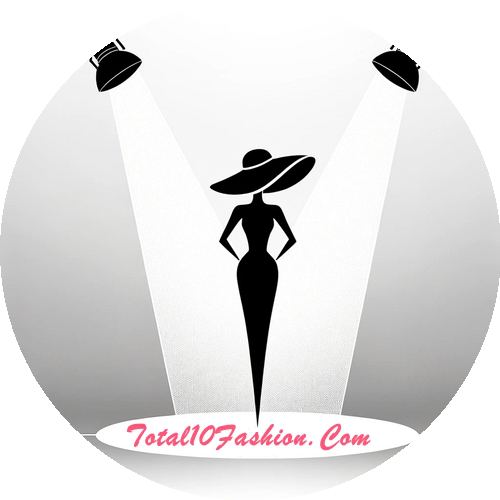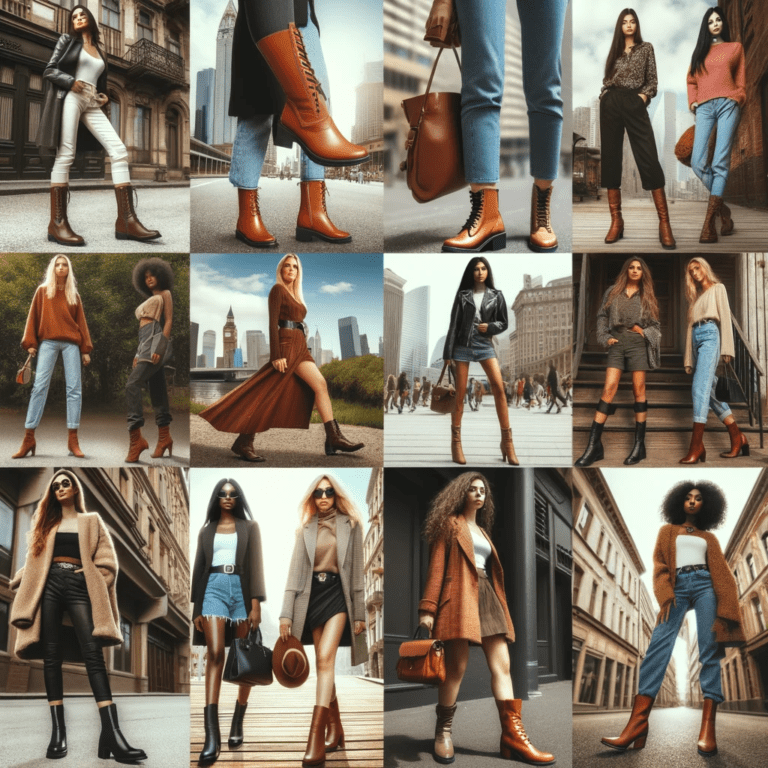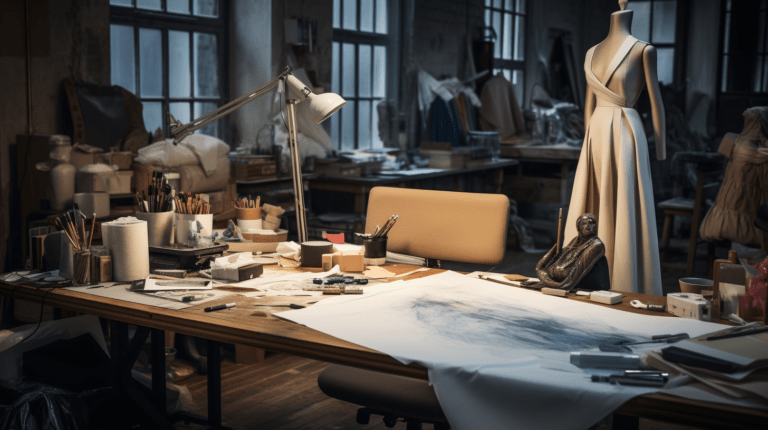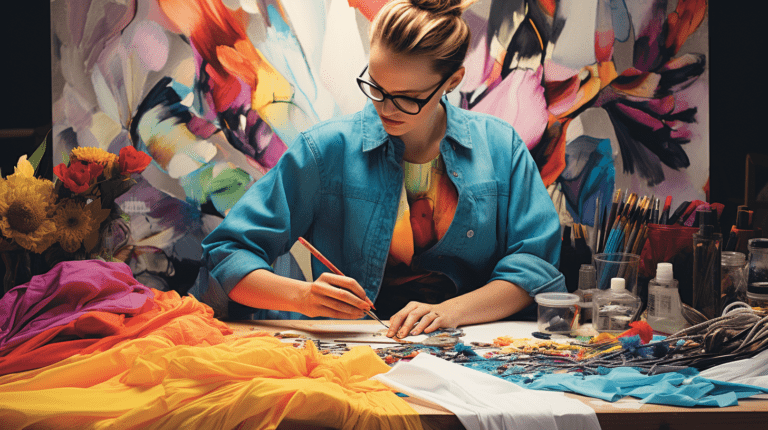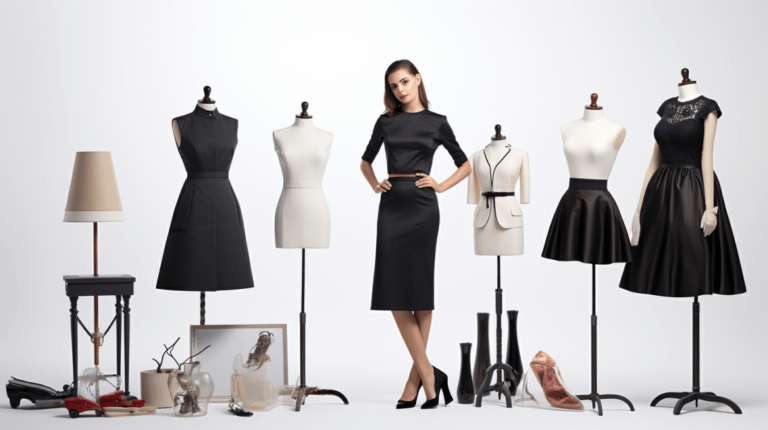How To Get Into The Fashion Industry – Did you know that the global fashion industry is worth over 2.5 trillion dollars? That’s a lot of potential for those seeking to make their mark in this dynamic, ever-evolving field. But breaking into fashion isn’t just about having a keen eye for style or knowing your Gucci from your Givenchy.
It requires dedication, creativity and an understanding of both business and artistry. In this guide, we’ll show you how to get started in the fashion industry – from getting the right education and building a striking portfolio, to networking effectively and showcasing your unique style.
Alongside these fundamentals, continuous learning and development are key to staying ahead of trends and carving out a successful career in this competitive field. So if you’ve got ambition burning brighter than any runway spotlight, read on – it’s time to turn your fashion dreams into reality.
How To Get Into The Fashion Industry: Key Takeaways
- Getting the right education in design is crucial, consider enrolling in renowned design schools like Central Saint Martins or Parsons School of Design.
- Developing a strong portfolio that showcases technical skills, fashion trend understanding, and personal aesthetic is crucial for success.
- Networking is crucial in the fashion industry, engage with industry influencers, attend fashion events, and maintain connections with established professionals.
- Continuous learning and development are necessary to stay ahead in the industry, consider online courses, self-guided studies, and attending fashion shows and trade expos to enhance skills and knowledge.
How To Get Into The Fashion Industry: Understand the Industry
You’ve got to truly grasp the ins and outs of the fashion industry before you can make your grand entrance. It’s not just about knowing what’s on trend or having an eye for design, it’s about understanding the industry dynamics – how different elements interact and influence each other.

Fashion is a high-octane world where creativity meets commerce, art converges with business strategy, and innovation ties in with traditional craftsmanship. Understanding these complexities is akin to learning a new language – one that is brimming with its unique terminologies, systems, and processes. You must become fluent in this language if you aim to reign supreme in this sphere.
Soak up knowledge about everything from textile production to retail distribution; immerse yourself in learning about different markets and their distinct consumer behaviors; familiarize yourself with global trade regulations affecting fashion trends.
Remember, fashion isn’t just an aesthetic pursuit. It’s a multibillion-dollar industry that thrives on constant churn and renewal. Every season brings fresh ideas, innovative styles, new designers who disrupt the status quo – all vying for consumers’ attention and dollars.
Being able to predict which way the wind will blow next is vital. Are skinny jeans still going strong or are bell bottoms making a comeback? What fabrics or patterns are hot right now? Being keyed into these shifts can give you an edge over competitors who merely follow trends rather than forecast them.
Now that you’re getting a feel for the lay of the land, it’s time we delve deeper into another crucial aspect: honing your educational credentials specifically tailored towards your chosen career path within this dynamic industry.
How To Get Into The Fashion Industry: Get the Right Education

Dreaming of a career in haute couture or street style? Start by weaving the fabric of your knowledge with a degree in design, same as 70% of successful designers did. It’s like planting the seeds of creativity and watching them bloom into an array of stunning designs.
You see, not only will you learn about fashion theory, but you’ll also gain hands-on experience creating garments that can turn heads on any runway.
Consider enrolling at one of the world-renowned design schools to get your foot in this glamorous door. Schools such as Central Saint Martins in London or Parsons School of Design in New York provide industry-focused courses that thrust you into the heart of all-things-fashion. Here, you’ll master everything from pattern drafting to garment construction while learning how to articulate your unique vision through clothing.
To broaden your horizons even further, consider studying abroad. Experiencing different cultures and fashion trends first-hand can enrich your perspective and strengthen your design aesthetic. Imagine absorbing inspiration from Paris’s cutting-edge couture scene or Milan’s luxury leather craftsmanship!
Now remember, it’s not just about acquiring technical skills; it’s equally crucial to develop a keen eye for trend forecasting and understand consumer behavior patterns – these are power tools for any aspirant seeking their place under the fashion sun.
As important as getting educated is to carving out a successful path in this thrilling industry, remember that nothing speaks louder than practical evidence of talent and hard work – which leads us right into our next topic: building a strong portfolio. Harnessing those skills learned both at home and abroad will help you create an impressive body of work showcasing your creativity and technical prowess, allowing you to stride confidently towards achieving dominance in the fashion industry.
How To Get Into The Fashion Industry: Build a Strong Portfolio

Building a robust portfolio can serve as your personal runway, showcasing your unique style and technical abilities to the world.
In the fashion industry, where competition is fierce and creativity is the currency, having a strong portfolio can be your passport to success.
When building your portfolio, it’s crucial to focus on two key aspects: Portfolio Content and Portfolio Presentation.
- Portfolio Content:
- Your content should reflect your technical skills, understanding of fashion trends, and personal aesthetic. Include sketches of designs you’ve made or photos of clothes you’ve constructed.
- Showcase your versatility by including a range of styles – from haute couture creations to ready-to-wear pieces. Remember, diversity in design can make you more attractive to potential employers.
- Portfolio Presentation:
- The way you present your work can say as much about you as the designs themselves. Opt for high-quality images and ensure they’re well-lit and clearly focused.
- Consider using an online platform or creating a website for an interactive experience that allows viewers to see different angles of each piece.
Remember, quality trumps quantity every time – so carefully curate what goes into your portfolio. Make sure each piece tells its own story about who you are as a designer.
Your efforts must not stop at creating an impressive portfolio; it’s just one part of getting into this glamorous yet demanding industry. You need people who matter in the industry to notice it too. So how do you grab their attention? The answer lies in networking effectively within the industry – something we’ll delve deeper into next!
How To Get Into The Fashion Industry: Network in the Fashion Industry

Networking is a powerful tool in your designer’s toolkit, and wisely leveraging it can skyrocket your visibility among the movers and shakers of the style scene. As an aspiring fashion professional, you must be proactive about creating meaningful connections within this highly competitive sector.
Here’s where industry influencers come into the picture. These are individuals who have significant sway in shaping trends and directing consumer behavior. Engaging with them can provide you invaluable insights into the workings of the fashion world.
Attending fashion events is another excellent networking opportunity. Whether it’s runway shows, trade fairs, or launch parties, these gatherings draw together designers, models, stylists, retailers – essentially anyone who’s anyone in fashion.
| Networking Strategy | Expected Outcome |
|---|---|
| Engage with Industry Influencers | Gain firsthand insight into trend forecasting |
| Attend Fashion Events | Meet potential collaborators and clients |
By interacting with these industry experts at such occasions, you build relationships that could lead to collaborations or job opportunities down the line. Remember: every conversation could potentially open doors for you in this dynamic industry.
Don’t shy away from reaching out to established professionals either; they’ve been where you are now and might be willing to share their wisdom or even mentor you along your journey.
It’s vital not just to make connections but also maintain them through regular interaction – follow up on conversations after meetings or events; stay active on social media platforms frequented by other fashion enthusiasts; keep sharing your work online so others see what you’re capable of creating.
As important as networking is for getting a foothold in this glamorous yet demanding field, remember that there isn’t a substitute for gaining hands-on experience inside the industry’s pulse-pounding rhythm. That comes next on your route towards becoming a force to reckon with in high-fashion circles.
How To Get Into The Fashion Industry: Gain Experience
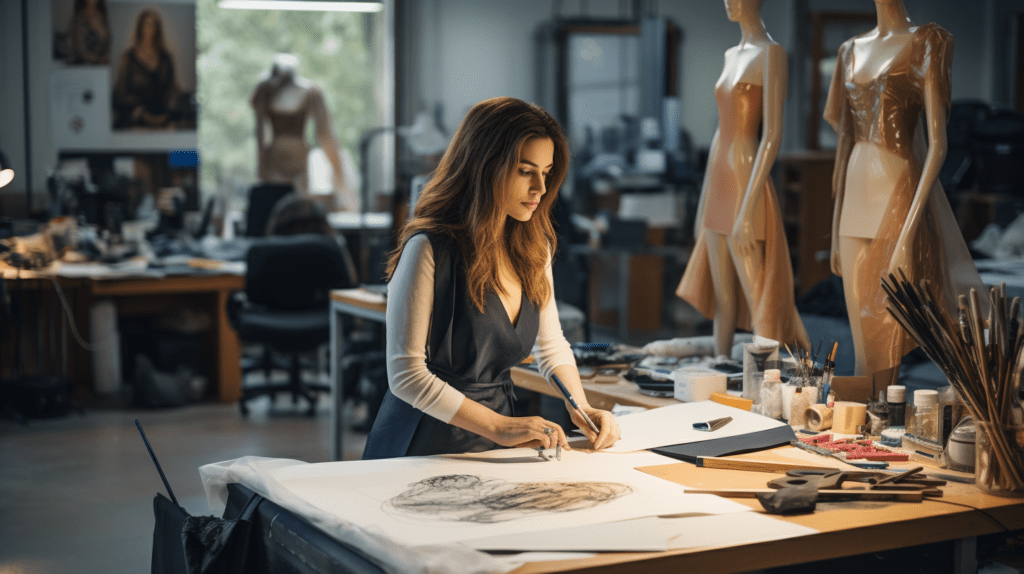
Diving headfirst into the fashion industry requires more than just a keen sense of style; it’s about getting your hands dirty with real-world experience. Scoring an entry-level job or landing an internship is a fantastic way to immerse yourself in the industry, understand its nuances, and build vital connections.
These opportunities not only provide valuable on-the-job training but also enable you to witness firsthand how various departments within a fashion house function synergistically.
Entry-Level Jobs
Landing your first entry-level job in the fashion industry can feel like a monumental triumph, as if you’ve just won an epic battle. It’s a crowning achievement that marks the beginning of your illustrious career.
To navigate this cutthroat arena successfully, it’s critical to develop strategic job search strategies. Consider roles such as a Fashion Assistant or Visual Merchandiser – positions that offer hands-on experience and exposure to the heart of this fast-paced world while providing salary expectations compatible with those starting out in the industry.
Remember, these initial roles are not merely jobs; they are stepping stones on your journey towards becoming a powerhouse in the fashion world.
Now, let’s delve deeper into another essential facet of breaking into the industry: internships. These opportunities offer invaluable experience while giving you an insider’s view of fashion’s pulse.
Internships
Like the legendary Coco Chanel who started as a hat maker, you too can kickstart your journey in the world of haute couture by grabbing an internship.
- Start by exploring different fashion houses and brands, looking for mentorship opportunities that align with your career goals.
- Once identified, prepare a compelling portfolio showcasing your unique design perspective and creativity.
- Finally, submit those internship applications fearlessly.
Remember, these internships aren’t just about gaining experience; they’re also an opportunity to build a robust network within this dynamic industry. You’ll be rubbing shoulders with designers, stylists, photographers, and other influential figures who could potentially become valuable allies in your ascent to fashion royalty.
Next up is how to make a statement by showing your unique style and creativity in this competitive landscape.
How To Get Into The Fashion Industry: Show Your Unique Style and Creativity
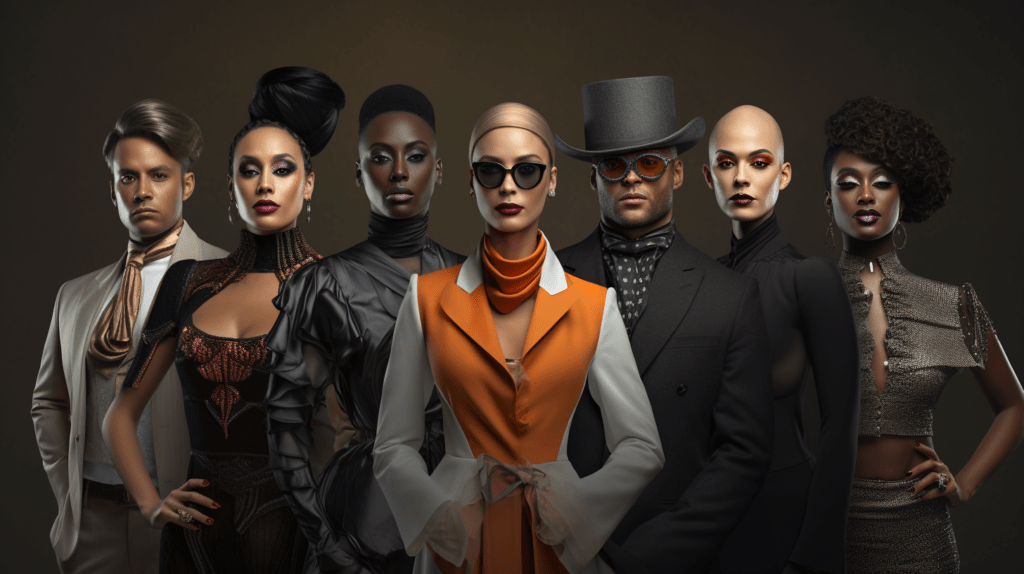
Don’t be afraid to let your unique style and creativity shine, it’s that spark within you that’ll set you apart in the bustling world of fashion. Personal branding is a crucial factor in distinguishing yourself from others, especially as an aspiring fashion professional. Your unique perspective on design, aesthetics, and trends can become your signature style. Be bold and innovative; experiment with different fabrics, cuts or styles; take on creativity challenges to test the boundaries of traditional fashion.
Developing your personal brand does not happen overnight. It involves continuous self-discovery and introspection into your values, passions, strengths, and weaknesses. Your personal brand should reflect who you are and what makes you distinct from others—your story matters. Align this narrative with your design principles: How do they make a statement about who you are? How do they address societal issues or contribute to the evolution of fashion?
Use social media platforms to showcase your work—Instagram is particularly popular for sharing visual content like sketches or finished pieces—and connect with other industry professionals. Attend networking events such as fashion shows or trade expos where you can meet potential mentors or partners who might appreciate your fresh ideas.
Remember that passion alone won’t cut it—you need grit too! The path to success in the competitive landscape of the fashion industry involves inevitable setbacks but remain steadfast in refining and promoting your distinctive brand.
Your journey doesn’t end here though—it’s essential to pursue continuous learning and development since staying ahead requires understanding emerging trends while honing technical skills related to designing, marketing among others.
How To Get Into The Fashion Industry: Pursue Continuous Learning and Development

While your unique style and creativity are crucial in setting you apart from the crowd, don’t underestimate the power of knowledge. The fashion industry is a fast-paced world that always keeps moving forward, just like the latest trends.
In this context, continuous learning and development become essential. Think of it as a journey rather than a destination. A career in fashion isn’t simply about getting there; it’s about constantly growing, evolving, and enhancing your skills once you’ve arrived. Forging ahead requires an unyielding commitment to expanding your understanding of the industry’s many facets.
Dive into self-guided studies or online courses to help fuel this growth. These platforms offer an extensive range of options—from basic design and tailoring to more complex subjects like trend forecasting and sustainable manufacturing—all at your fingertips. Utilize these resources not merely for gaining theoretical knowledge but for shaping practical skills that can be directly applied to real-world scenarios.
Online courses also provide opportunities to engage with experienced professionals worldwide—the ones who have walked the path before you—and absorb invaluable insights from them. Remember, every interaction is a chance to learn something new.
The hunger for knowledge should never cease—it’s what will keep your creative spark alive amidst the constant flux of trends in this dynamic industry. So continue pursuing education relentlessly because that’s what will push you towards greater heights in this cutthroat environment.
So gear up! Grab every opportunity available for honing your craft—whether through formal education or self-taught routes—and keep pushing boundaries with relentless curiosity and unwavering passion!
Frequently Asked Questions
What are the potential health risks or physical demands of working in the fashion industry?
Working in the fashion industry can certainly put your health at risk and demand physical endurance. Many models follow strict dietary restrictions and rigorous physical training to maintain a certain physique.
Prolonged periods of standing, heavy lifting, and high-stress environments are common. Long working hours can impact sleep patterns, negatively affecting overall well-being.
It’s crucial to balance these demands with proper nutrition, rest, and self-care to ensure success without compromising health.
How has the rise of digital and social media changed the fashion industry?
Digital and social media have revolutionized the fashion industry. You’ve seen influencer impact skyrocket as tastemakers dictate trends, making fashion more democratic.
E-commerce evolution has made shopping a 24/7 activity, expanding global reach while reducing overhead costs.
You hold power; you can decide where, when, and how to shop or influence. Embrace this digital shift to stay competitive in this fast-paced industry.
What are the typical working hours in the fashion industry?
In the fashion world, your working hours can be unpredictable. Often, you’ll start early and finish late, especially during peak seasons like Fashion Week. This depends on your role and career progression though.
As an entry-level employee, expect longer hours with lower salary expectations. However, as you climb up the ladder, you may have more control over your schedule but still face demanding deadlines.
Remember – power in this industry means being adaptable and always ready to deliver high-quality work.
How is the fashion industry addressing issues related to sustainability and ethical production?
The fashion industry is addressing sustainability by adopting sustainable sourcing practices, like using recycled or renewable materials.
Ethical branding has gained traction as they prioritize fair trade and workers’ rights.
You’re witnessing a shift towards transparency, where brands openly share their production process to prove ethical compliance.
You’re in an era where power lies with the consumers – your purchasing decisions can make a difference in the push for a more sustainable and ethical fashion industry.
What are the mental health challenges associated with working in the fashion industry?
The fashion industry’s high-pressure environment may exacerbate mental health challenges. Stigma perception can deter you from seeking help, while the relentless pace might limit therapy accessibility.
The demand for constant creativity and perfection can lead to stress, anxiety, even burnout. Furthermore, body image issues are prevalent due to unrealistic beauty standards.
Harnessing power in such a scenario entails acknowledging these challenges and advocating for healthier work environments and practices.
Conclusion
So, you’ve got the lowdown on breaking into the fashion world. Remember, it’s not all glitz and glamour; forging your path requires hard work, creativity, and continuous learning. Like a knight charging into battle with a sewing needle instead of a sword, you’ll need to arm yourself with knowledge and experience.
The industry awaits your unique style and vision – go forth and conquer!
